Projects
Signed by Dr Zaluzhnyi
What keeps the evacuation of the wounded near Bakhmut going
Written by Dmytro Fionik
Photos by Valentyna Polishchuk
Layout by Yuliia Vynohradska
On 24 June 2022, Ukrainian Armed Forces Commander-in-Chief Valerii Zaluzhnyi authorised the Pirogov First Volunteer Mobile Hospital’s (PFVMH) participation in the medical evacuation of wounded troops. His resolution resolved a misunderstanding between the Medical Forces of the Armed Forces and volunteer medics. Mr Zaluzhnyi’s signature saved thousands of wounded.
LIGA.net has witnessed how the wounded are evacuated from Bakhmut to hospitals in Sloviansk and Kramatorsk; how the mobile hospital is arranged; how volunteers are recruited; and, last but not least, what was the essence of last year’s conflict between the PFVMH and the Medical Forces.
Starring
Serhii realises that he has survived. He is lying wrapped in a golden thermal blanket in an ambulance car, catheters attached to his body, an intravenous drip swinging. A doctor in blue gloves says something funny. Serhii tries to smile and raise his hand, but his palm with a massive gold ring falls on the foil. Mozart’s Piano Concerto No. 21 is playing from the driver’s cab.
A few seconds later, the wounded man closes his eyes. The smile does not leave his face. The doctor does not let him fall asleep.
“Serhii, can you hear me? What kind of ring do you have… Are you married?”
“Fourteen years…”
“You should be given an order,” the doctor does not stop talking.
“It’s her who needs an order… Can I smoke?”
“No-no-no.”
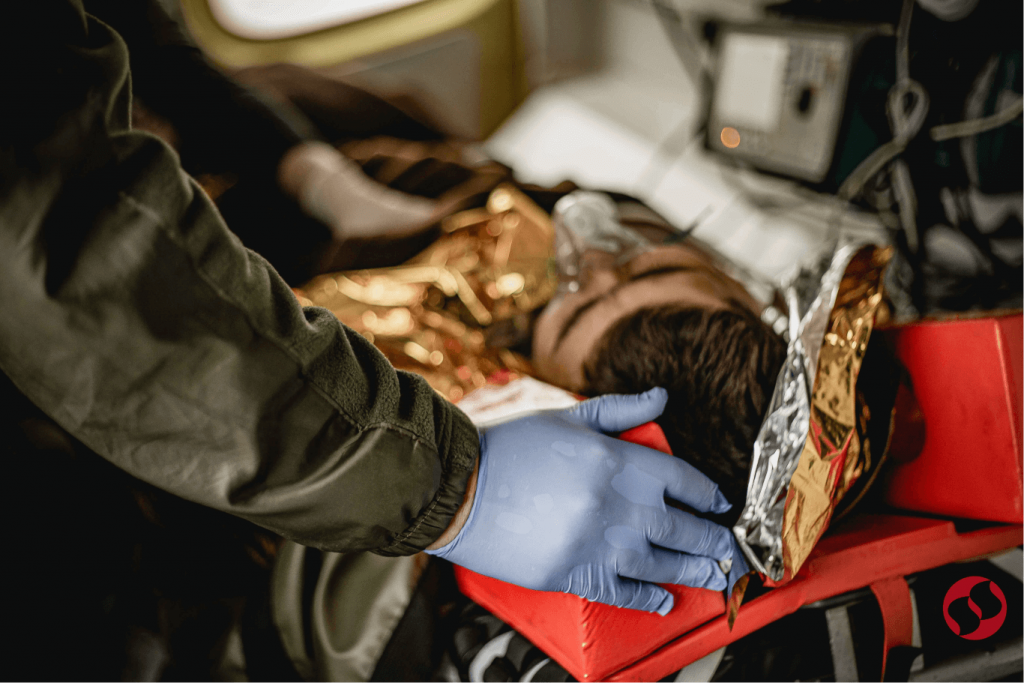
Serhii does not know he is dying. He has a shrapnel wound to his head – in fact, a fragment of his skull is missing – and two gunshot wounds to his thigh and foot. His survival in the next forty minutes depends on the providence and professionalism of the doctor. The fact that Serhii is still conscious is a miracle.
The scene is a resuscitation vehicle of the Pirogov First Volunteer Mobile Hospital, en route from Kostiantynivka to Kramatorsk. It is Monday, noon, and the battle for Bakhmut is ongoing.
Skrypal [Fiddler] (Viktor Skrypchenko), an anaesthesiologist from Sumy, and Poltava, a nurse, are operating on the wounded Serhii (Skrypal and Poltava are callsigns). Behind the wheel is Mozart, known in civilian life as Oleksandr Maslo, a Kharkiv musicologist and director of a music school in Kharkiv. To the driver’s right is security guard Krava (Ruslan Kravchenko), who had worked at a construction equipment factory near Kyiv before the full-scale war.
Between the driver and the security guard is a random passenger; that is, me. If you tilt your head back a little, you can hear what’s going on in the cabin.
Swearing to the sound of the piano
From Serhii’s slow and fragmentary narration, one can reconstruct the events he has experienced over the past twenty-four hours. His squad was defending a high-fenced area of the industrial zone in Bakhmut; in the evening, a Russian tank pierced a hole in the fence, through which enemy infantry swarmed in.
By the morning, three were still alive – Serhii, another shooter, and the squad leader; all three were wounded. Serhii covered the bleeding on his head with a cap. The commander’s spine was broken by a piece of shrapnel, and his lower body was paralysed, but the man could still shoot. The commander ordered his men to retreat, and covered them for as long as he could.
While retreating, the most difficult thing Serhii and his comrade faced was crossing the tracks. Serhii does not know what happened to the other man. When he was jumping over the rails, he was hit by machine gunfire. Serhii got another two wounds, managed to put a tourniquet on himself, and went to his positions. The sky was shaking with a terrible amplitude, and he was moving ‘on adrenaline’.
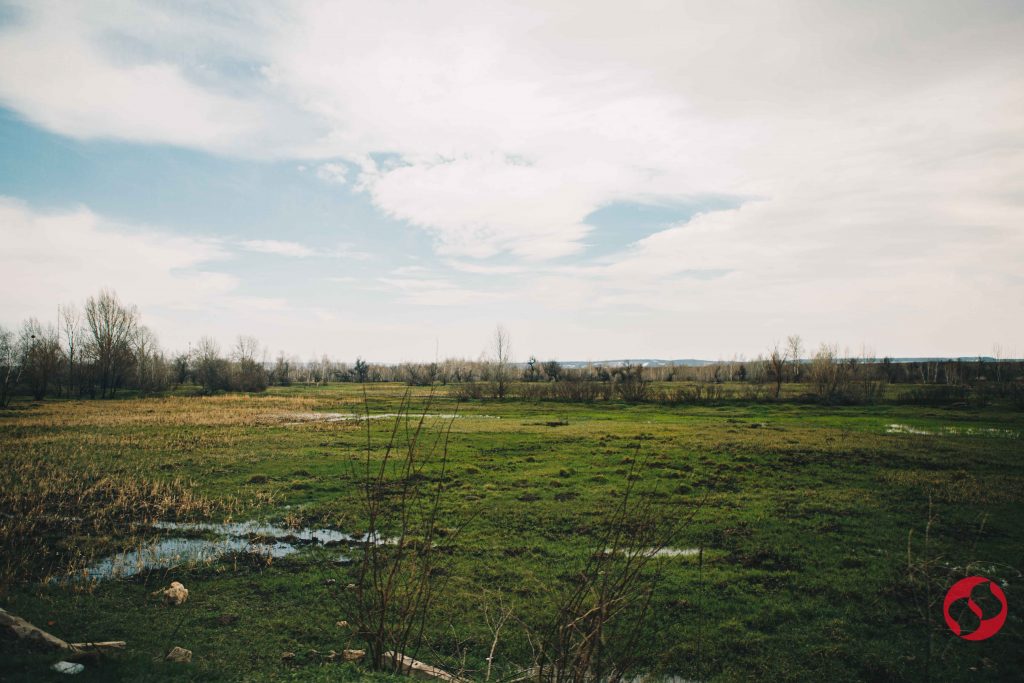
Spring in Donbass
It is almost impossible to believe, but it is a fact: A man with a shrapnel in his cerebral cortex walked on his own to a stabilisation (stab) unit near Kostiantynivka. Serhii believed he was just lightly wounded, an illusion that had given him strength. The last and perhaps the most difficult test of will was the five steps up to the reception of the Apostle Peter, i.e. to the stab unit outside of Kostiantynivka.
Short questions and short answers followed. Then, clothes were cut, the remaining equipment thrown into a black garbage bag… Instead of blood-soaked camouflage, regal clothes made of golden foil, a urinary catheter, painkillers, sedatives… And then he was loaded into an ambulance.
The car was just a few metres away from the stall porch when it started to rain. As soon as the drops touched his face, Serhii smiled, for the first time that day. The doctor was obviously jovial. Serhii was still conscious, but it was getting harder for him to speak. “Fourteen years… married…”
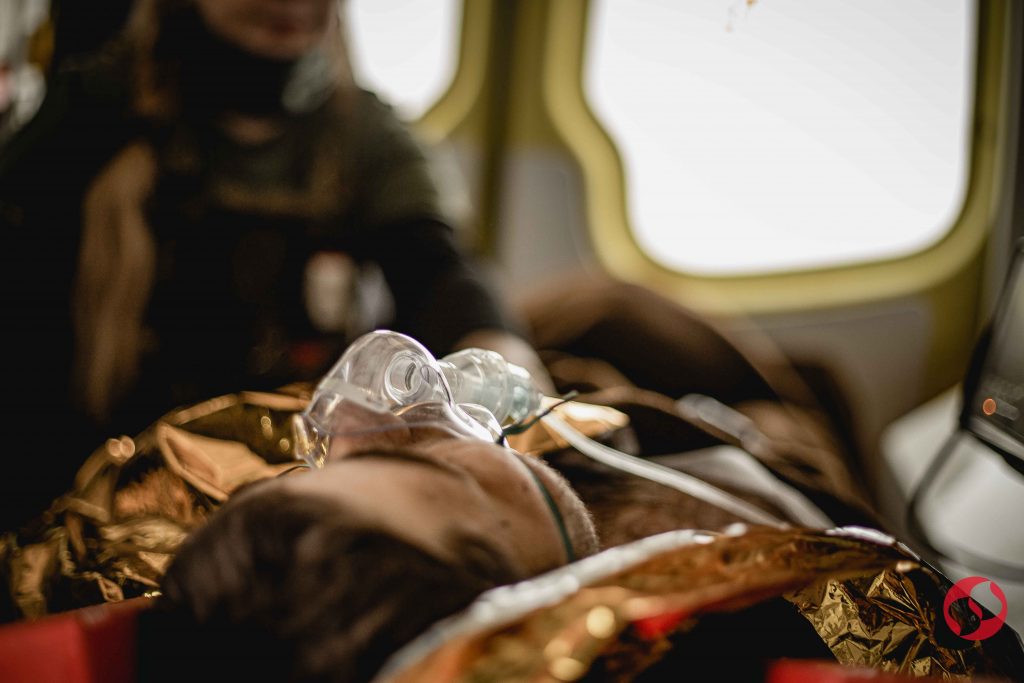
“Oxygen,” Skrypal commanded. Nurse Poltava put a mask on Serhii. The conversation stopped. Some metal cabinets were opening in the car, the car shaking, something falling down…
“Mannitol, solution,” Skrypal continued to give orders. “Mozart, can you stop?”
A minute later, we set off again. “If the road has no potholes, let’s have a breeze,” Skrypal shouts to Mozart. The road is slippery, but the driver is picking up speed.
The rain hits the windscreen. Outside the windows is a black-and-white landscape of early spring: trees and the outlines of grey houses in Druzhkivka, looking like blurred X-rays.
In forty minutes, the weather changes twice. Twice, the sun peeks through the clouds. Twice, the ray touches Serhii’s wedding ring. Twice, the car stops.
Finally, Kramatorsk. Almost there, but the key word here is almost. At the first major intersection, the siren button jams. And this is a problem.
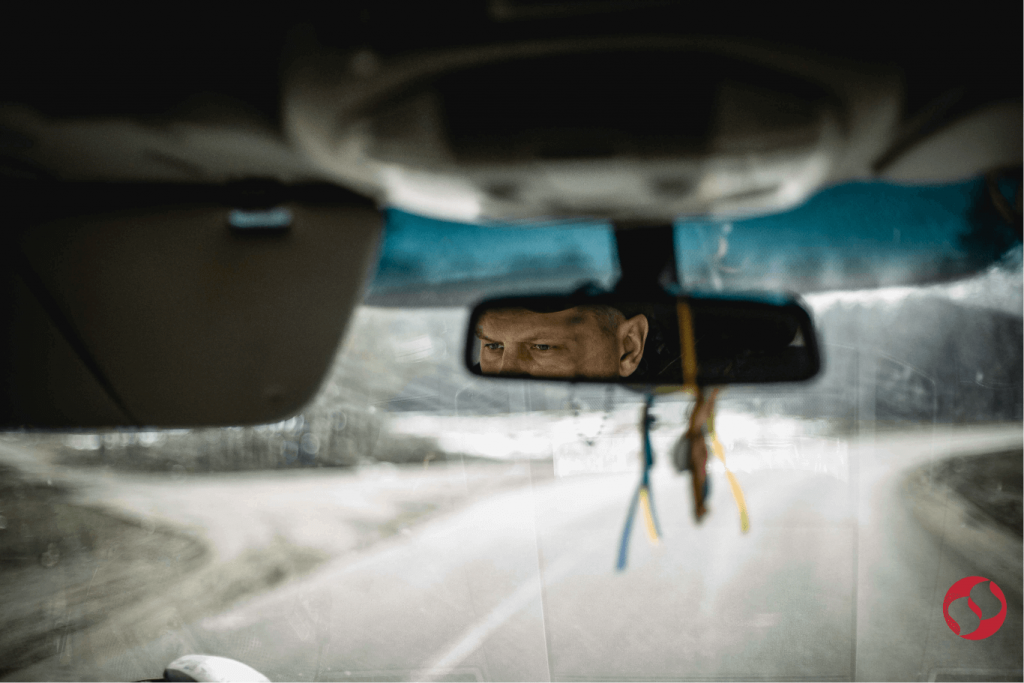
Despite the slippery road, the ambulance moves at max speed
The mystery of the Magic Flute
The ambulance team’s shift starts at eight in the morning. From then on, the team waits for the first call. When the radio rattles off general information about the wounded, the team members have a few minutes to finish their current tasks – wash their coffee cup, dive into their armoured vests, and run to the car.
After each trip from the stab unit to the hospital, the car goes to the ‘base’. The base is a house in the private sector of a settlement, a few minutes’ drive from the stabilisation unit. It has a toilet, snacks, and even a place to lie down until the next call comes in. And so on until it is eight in the evening.
At night, unless absolutely necessary, medics avoid travelling on frontline roads.
That all is a theory, an ideal situation even. If the stab units are overloaded, things are different – like in the last few days.
Today, the working shift of the ‘music team’ of Skrypal and Mozart began at seven twenty.
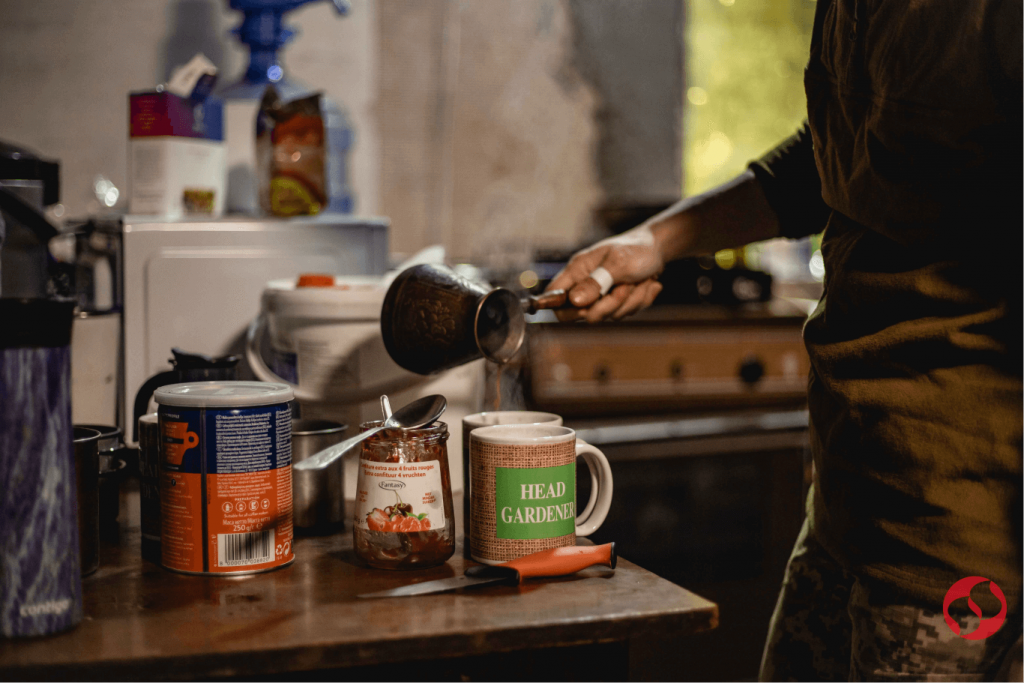
The ‘base’ has a place to rest, have a snack, even lie down until the next call comes in
After Serhii was taken to the hospital, the ambulance went to the ‘base’ for lunch. In a few minutes, Poltava set up a buffet with sausage; cheese; a plate of vegetables including cucumbers, tomatoes, and peppers; and a ‘chef’s dish’, a flower made of thin slices of orange and kiwi.
The moment the men saw this gastronomic miracle a call came in. There was only enough time to stuff their mouths with sausage and hastily shove the whole piece of buffet art into the fridge.
The next patient was Vasyl, with an abdominal injury. He was diagnosed with eventration, that is the protrusion of contents of the abdomen. Vasyl had also walked to the stab unit on his own, covering the wound with his hand, through which the loops of his intestines were falling out.
Vasyl was taken to hospital without incident. More or less full-fledged communication, when the wounded is able and willing to tell something during the journey, is rare. Three more wounded transported by the ‘music team’ on the same day were in a medically induced coma, breathing through a tube. An ambulance equipped with an artificial lung ventilation (ALV) device is the only possible means of transport for them.
On the way to the ‘base’, I asked the driver who he would commission to write the music titled ‘The Battle of Bakhmut’ if all classical composers were alive?
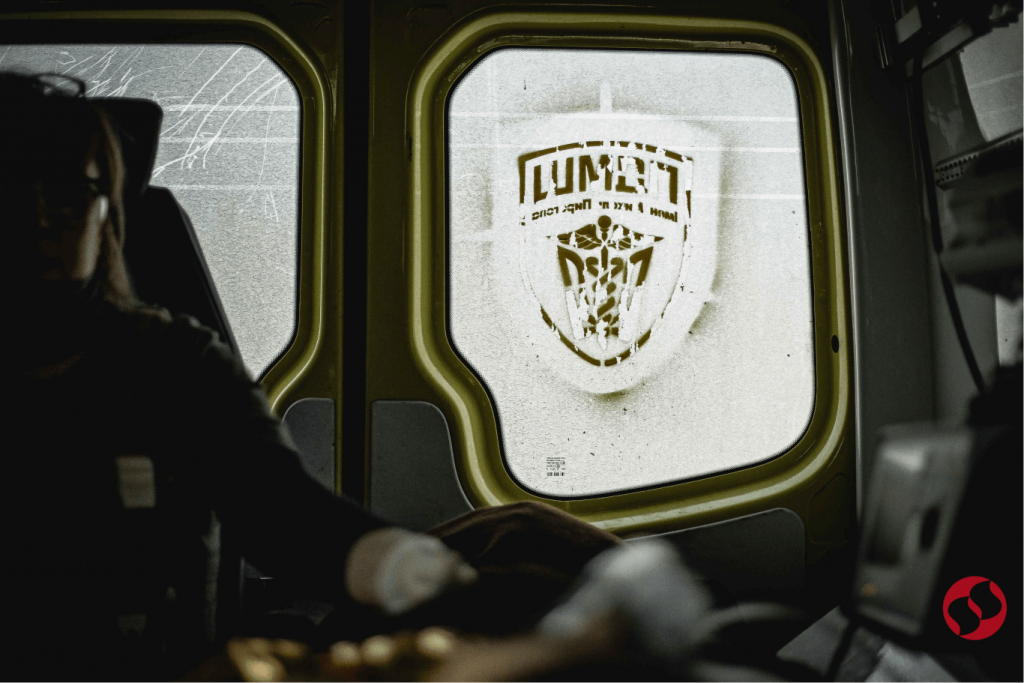
This question was too serious. The musicologist spent twenty minutes listing composers of the past and their shortcomings.
“I cannot answer this question,” Mozart finally exhaled.
But that was just the beginning. He went on to analyse Richard Wagner’s twelve-hour opera, shining a distant light on Romanticism; mentioned Mozart’s Requiem twice.
At the end of this lecture, he recommended that I listen to ‘The Magic Flute’, an opera by his namesake. It is not clear what the connection between Bakhmut and the opera is; probably nothing, but the music is great.
The libretto is simple, almost childlike. The Prince escapes from the serpent, receives a battle artefact – a flute – from the Queen of the Night, and, armed, accompanied by his servant, sets out in search of his beloved.
At first, he is under the power of the witch, the Queen of the Night, and then, the sorcerer Zarastro. The ending, of course, is happy.
The philosophy behind the opera becomes clear if the characters are looked upon as elements of one personality.
The ambulance rose above the poorly lit villages, forests, and hills and flew into the domain of the Queen of the Night. As Krava listened, he went deep into his thoughts, and Skrypal and Poltava giggled.
And Mozart went on to reveal the secrets of ‘The Magic Flute’. The Prince is the inner self, which has to make a choice. The servant is the bodily nature. The main aria of the Queen of the Night is revenge. The sorcerer is the mind. The beloved is the pure soul, love.
To gain a pure soul, one must go through a number of fantastic trials. Over time, the Queen of the Night turns from an assistant into an enemy. In this fairy tale, there are no unambiguously bad characters at all – except for the serpents. There is just the time of the Queen of the Night and the dawn, which one still has to live to see. And the magic flute is probably inner harmony.
“Mozart is a genius,” Mozart concluded. “It is impossible to understand him.”
And so we arrived. The working day ended where it began, at the PFVMH base in Sloviansk. At this hour, the ‘base’ was almost asleep.
Tomorrow, dozens of medics, drivers, and security guards would face another exhausting day. In the semi-dark dining room, the cook’s assistant Shaia, a financier in civilian life, was still clanging pots and pans. One could ask her what was left after dinner. Somewhere in the corridor, Sova [Owl], the cleaner, was wielding a mop.
Queen of the Night
It is not by coincidence that Sova was not sleeping.
At eleven, the lights were supposed to be turned off at the ‘base’. By that time, I had managed to exchange a few words with her. The first thing that caught my eye was her penetrating gaze.
Sova is thirty. In civilian life, she is Olesia Leichyk, a digital artist, creating worlds of browser games, and painting in oils and watercolours as well. However, classical painting today is not enough to make ends meet.
After Russia’s full-scale invasion started, Sova grabbed her 10-year-old son in her arms and rushed from Kharkiv to her mother in Okhtyrka, a town in the neighbouring Sumy region. It turned out to be the right choice: A couple of months later, her house in Saltivka, a residential district in Kharkiv, was destroyed to the ground by the Russians.
But Sova remembers her escape as something shameful.
Since then, the artist has been looking for a way to atone for her guilt. She enrolled in nursing courses and applied to the PFVMH twice. In the end, she got in.
“Is it hard for you?” I ask.
“Well… It’s not easy,” Sova sighs tiredly. “Although I’m in good shape, I’ve been practising Wing Chun for many years. But this work is a challenge, a test on a spiritual level.”
Sova is a Buddhist. She perceives her act of service as a spiritual practice, a koan. This term has no analogues in the Christian tradition, but it can be explained as a parable-riddle in which the student is the protagonist of the parable. For example, a teacher tasks a student with understanding how the clapping of one hand sounds.
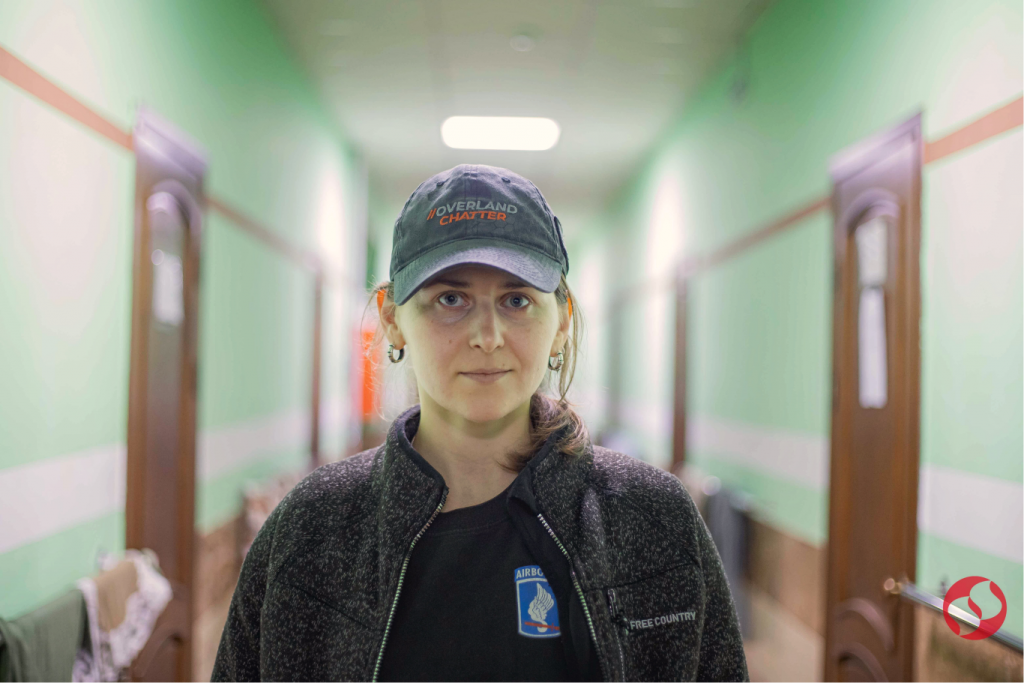
When most residents of the ‘base’ are already asleep, the working day of the cleaner Sova (in civilian life, Kharkiv artist Olesia Leichyk) goes on
What does Sova want to feel while cleaning the floor? The sound of a magic flute?
“It’s the time of Kali Yuga,” she says. “We are moving towards a reset, there is a lot of dirt in the world…”
“And now you are clearing it up,” I joke.
It’s hard to carry on a conversation. My fragmentary knowledge is only enough to remember that Kali is a blue woman with four arms. But I may be mistaken.
Bidding Sova goodnight, I googled ‘Goddess Kali’. Right on the money!
“The four arms symbolise the four cardinal points… The goddess of eternal power, time and change, death and destruction, usually depicted as dark and fierce… After the era of Kali Yuga, the renewal of time begins.”
The next word is ‘koan’. Interestingly, one of the collections of koans written in Ancient China was called ‘The Iron Flute’. Again, the flute. And again, the Queen of the Night, that is, Kali Yuga.
The country of doctors
For several days, the photographer and I had the impression that we were in one of the fantasy worlds of the writer Eric Russell.
Imagine that you are on another planet and you need to establish diplomatic relations with the locals. Everything looks like it is on Earth: You have a city and people in it, but don’t know who is in charge, where the government is, or what the laws are.
Suddenly, it turns out that there are no administrative buildings; the president is a local cobbler; the economy minister is a part-time janitor; the person in charge of relations with other planets is a bus driver; and there are no police because laws are rarely broken.
But should that happen, the offenders pack up and move to another city with different laws. No one considers them criminals; moreover, some are granted the status of honorary citizens and always welcome back.
The basic rule is that everyone works in sync. Someone may not be able to stand it. And this, of course, is not a crime.
This is roughly how the PFVMH is organised. All employees in the frontline area are subordinated to Svitlana Druzenko (callsign Lana). Her official title is Deputy Medical Director of the PFVMH. It is difficult to meet her during a working day: She is a paramedic on one of the resuscitation vehicles and, as a paramedic, herself subordinate to a doctor.
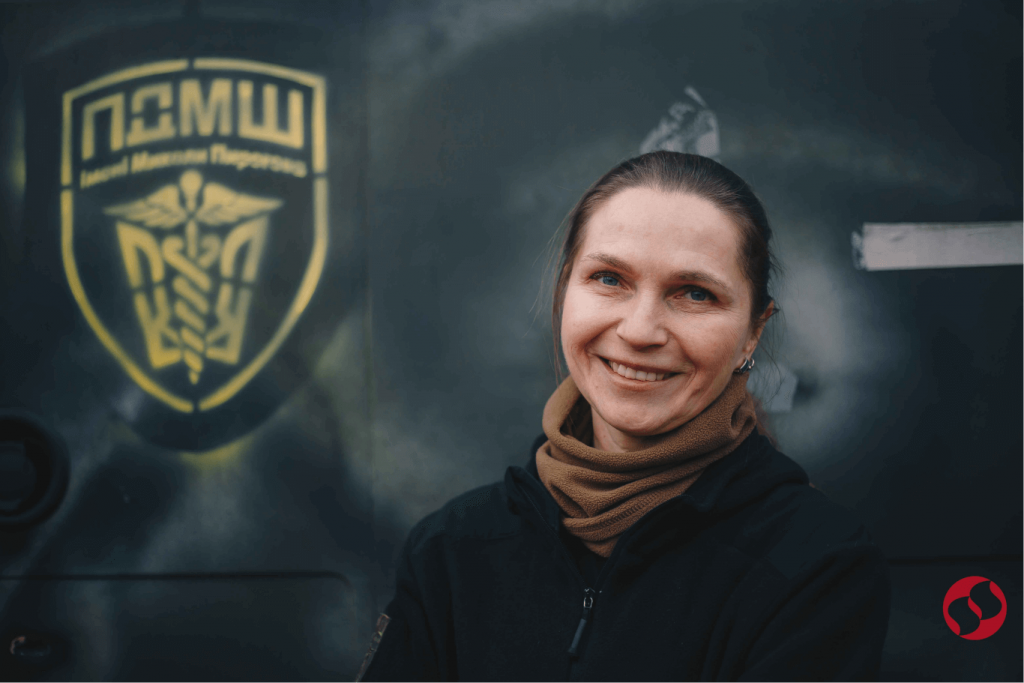
PFVMH Deputy Medical Director Svitlana Druzenko, callsign Lana, is also a paramedic on one of the resuscitation vehicles
Some administrative issues are resolved between nine and ten in the evening, when most of the medics are at the ‘base’. The system of team duties is arranged in such a way that there are no extreme situations that require Lana’s immediate intervention.
Each team is assigned to the ‘second line’ on the day following their shift. The second-line teams go out when the first line is overloaded or something unforeseen happens. This schedule allows the teams to both rest and feel that their colleagues will lend a shoulder in case of emergency.
The system of work has been polished to the minutest detail for eight years and three months – as long as the Pirogov First Volunteer Mobile Hospital has been in existence. By February 2022, the mobile hospital had treated 56,000 patients, both military and civilians of the ‘grey zone’. The exact number of wounded who have been treated by the PFVMH since 24 February has not yet been disclosed, but it runs to thousands of soldiers every month.
Today, the geography of the country of doctors with a fantastic state system is as follows. The stabilisation and evacuation units, where PFVMH teams constantly work, are located on a 100-kilometre line from the settlement of Novoliubivka in the north to Kostiantynivka, outside of Bakhmut, in the south. However, the units’ exact location depends on the situation on the frontline and changes periodically.
Four evacuation vehicles – two Humvees and two Pinzgauers – transport the wounded from the evacuation units to the stab units in Lyman and Kostiantynivka. Then seven resuscitation vehicles with ventilators, defibrillators, oxygen cylinders, and other equipment carry the patients to the hospitals in Sloviansk and Kramatorsk.
This is the general scheme of the teams’ work. In fact, it is more complicated, as the PFVMH also employs rehabilitation specialists and therapists who treat common diseases of the frontline soldiers. There are about 70 to 100 hospital-on-wheels employees who risk their lives every day.
For every non-standard problem, the hospital has a non-standard specialist. For instance, one of the volunteers with the call sign Chernihiv, the former head of the Chernihiv Regional State Administration and now an evacuation team driver, Andrii Prokopenko, helps solve some issues at the level of governmental structures – one might call it government relations. On the PFVMH website, Mr Prokopenko is titled ‘strategic communications director’.
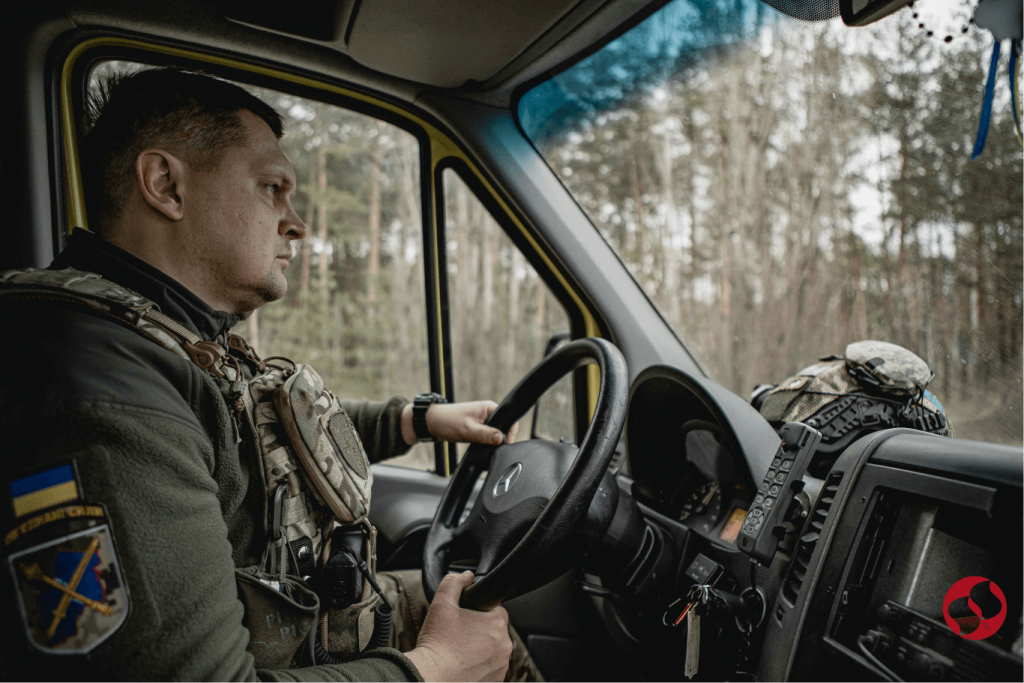
Andrii Prokopenko, former head of Chernihiv Regional State Administration, now an evacuation team driver
Not far from the stabilisation unit in Lyman, there is a house where medics rest, with some surgeons and anaesthetists living there permanently. The living room looks like a hotel in the mountains where climbers live: There is a lot of equipment similar to that of a tourist.
On the edge of the dining room table, Chernihiv spread out notebooks and was quickly typing something on his smartphone.
“Andrii, a couple of questions…”
“Hold on, I need to move 70 tonnes of rebar for our rehabilitation centre.”
In the course of the conversation, it became clear that for Chernihiv, the PFVMH is not only volunteering, but also a kind of social and philosophical experiment. He sees this community of medics as a manifestation of the invisible social transformations taking place in Ukraine during the war.
Mr Prokopenko is a PhD in philosophy. Given how seriously he began to analyse the PFVMH community through the prism of the British sociologist Anthony Giddens’ structuration theory, he did not buy his scientific degree.
The radio on Chernihiv’s bulletproof vest beeped, signalling a need to depart. He did not have time to sum up the results.
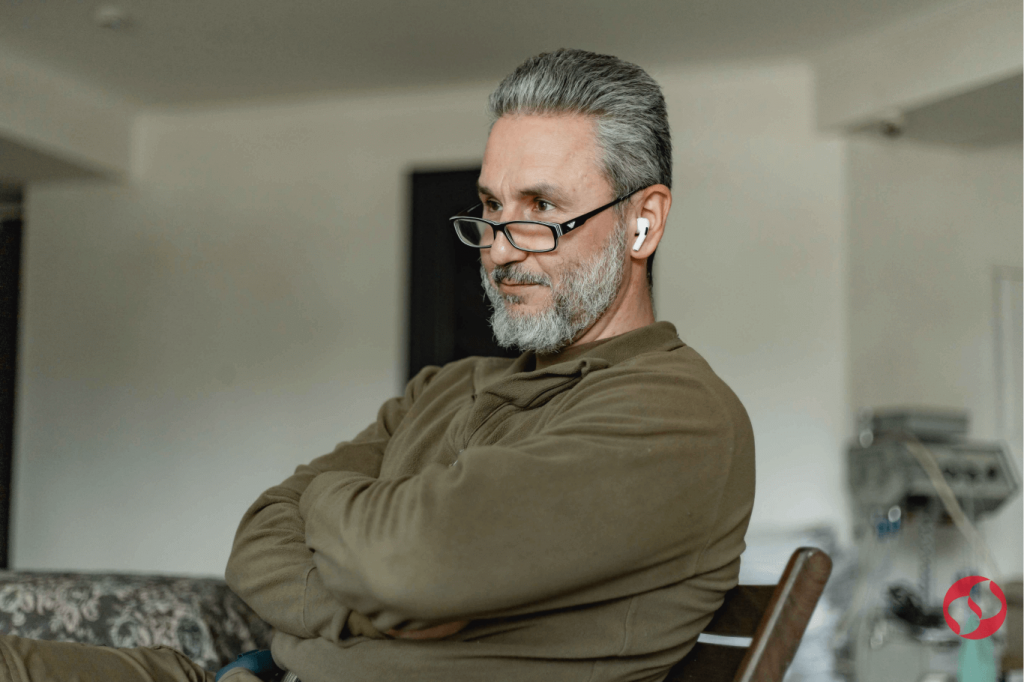
PFVMH President Hennadii Druzenko does not consider himself a boss. “We have no power in the usual sense; instead of power, we have coordination”
A few days, the summing-up would be done by the man who founded the PFVMH with his friends in 2014 and has been its head ever since, Hennadii Druzenko, a lawyer and Svitlana Druzenko’s husband.
During our meeting in Kyiv, Mr Druzenko came up with a general formula.
“At the PFVMH, there is no such position as ‘nachalnik’ [boss]. We have no hierarchy, no authority in the usual sense. Instead of power, we have coordination – and authority, which is hard to earn but can be lost at any time.”
But let’s get back to Lyman.
The treadmill of suffering
The Lyman unit is probably one of the largest in the so-called “yellow zone.” While the PFVMH medics are transferring another wounded man (traumatic amputation of the left foot) from one trolley to another, they have time to smoke on the porch.
At this moment, a minibus brakes sharply in front of the entrance. The vehicle is so dirty that it is impossible to identify the brand. A soldier with an assault rifle dashes out of it and in one jump overcomes the stairs, grabs the first stretcher he finds (all the stretchers here are covered in bloody archipelagos) and throws them into the minibus. And then another one. And another one.
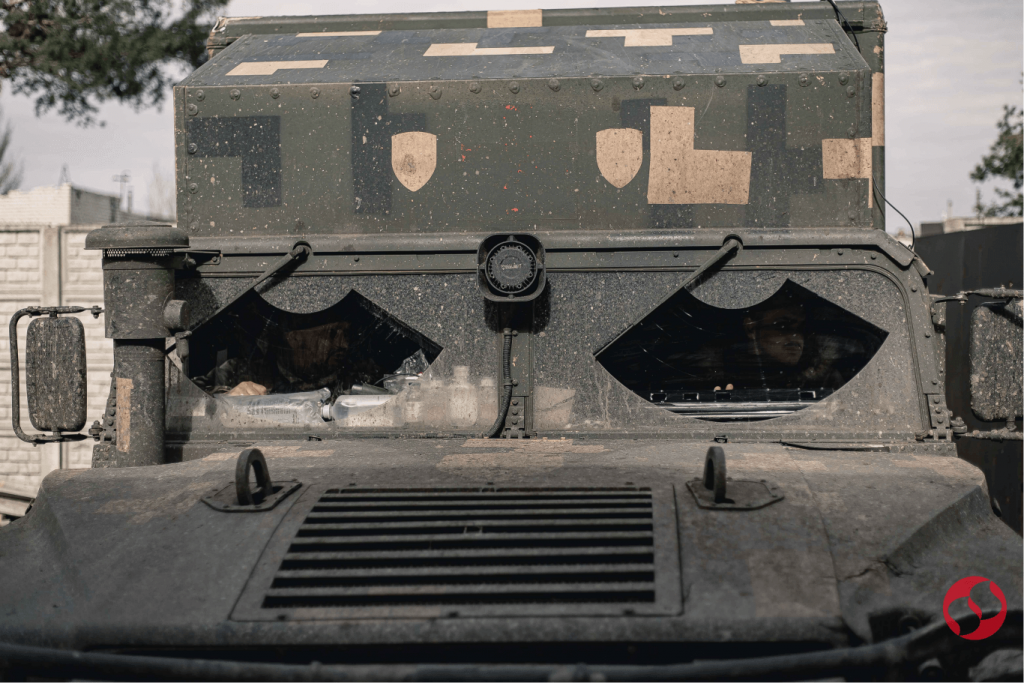
Four evacuation vehicles – two Humvees and two Pinzgauers – transport the wounded from evacuation points to the stabilization units
At the same time, his companion pulls out the bodies of his three comrades through the trunk door. It seems that they were travelling on top of each other. Faces black with soot, clothes black with blood… Mud instead of legs… No moans, no signs of life. Only one wounded man, looking up at the sky, raised his hand to greet someone, held it for a second and then lowered it. It was as if he had packed himself in.
In two or three minutes, an irritated voice would reach me: “What can I do if they’re dead!” Then a bearded man will stagger out onto the porch, bend over the railing and start vomiting. A wheelchair will be wheeled out behind him.
With one hand, the doctor steers the trolley, in the other he holds a blue garbage bag with the leg. In the same hand he holds some papers. “Hold this, please,” he says to me and holds out his hand with the bag and papers. I take the papers. I reflexively glance at the document and manage to read it: “Valerii (further illegible), born in 2004”.
For a moment, the doctor holds the bag up to his eyes — does it drip? It doesn’t seem to be dripping. Three men in dirty camouflage come out behind the trolley. Some of them have contusions, others have bandaged fingers. All of them are being loaded into the PFVMH ambulance. There’s not enough room for me in the vehicle, which means I’ll wait until it makes a round trip, delivers a batch of wounded to Sloviansk and returns to Lyman.
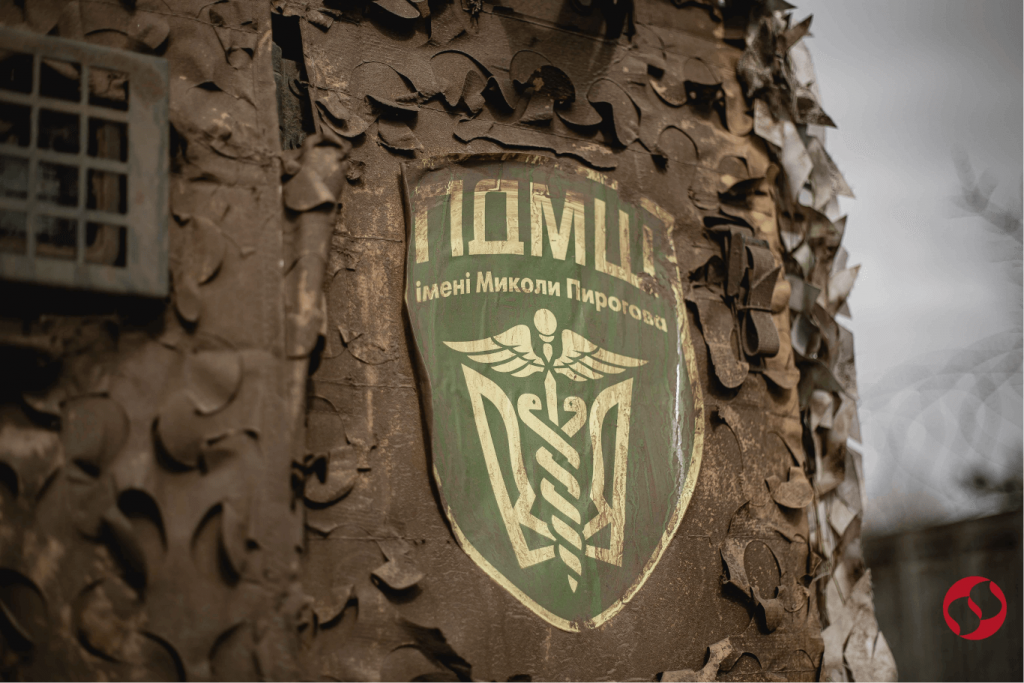
It takes about an hour and a half to get there and back. All this time, vehicles were coming and going to the porch. I counted 10 newly arrived wounded. All of them were seriously wounded. They were brought by vehicles labelled as PFVMH, Hospitallers, MOAS (international charitable foundation) and the Life Saving Center. Sometimes they were soldiers’ vehicles that had been broken down.
I didn’t see a single Ukrainian Armed Forces ambulance that day. This leaves me with a very sad impression: the evacuation of the wounded in this area is the responsibility of the wounded themselves and their comrades. And volunteers.
An important clarification: this is not an investigation, but an impression. I am not claiming that the Ukrainian Armed Forces ambulances do not exist per se. But, I repeat: I have not seen them. However, I have seen many volunteers. Where do they come from?
Volunteers
If we are to indicate PFVMH locations on the map of Ukraine, we should start with Kyiv. Here, the organization’s financial issues are resolved, warehouses are filled, equipment is repaired and volunteers are recruited. When the one-month rotation is over, another team steps in to replace the one on duty.
All PFVMH locations are classified. All we can say is that each of them has a fairy-tale atmosphere. For example, the Kyiv one: a wooded outskirts of the city, an unfinished prevention facility. There is a combination lock on the first floor. At the entrance, each visitor gets a friendly sniffover by a black hound named Dave. Here are the offices of the PFVMH’s permanent Kyiv staff. These are the rooms where they actually live.
For more than a year, 23-year-old PFVMH HR manager Darya Ripna has been processing applications of doctors, paramedics, nurses, drivers and other specialists. During this time, trends in the volunteer market have changed. In the first months of the war, there were so many applications that it took potential volunteers a while to get into the team. Today, it is more difficult.
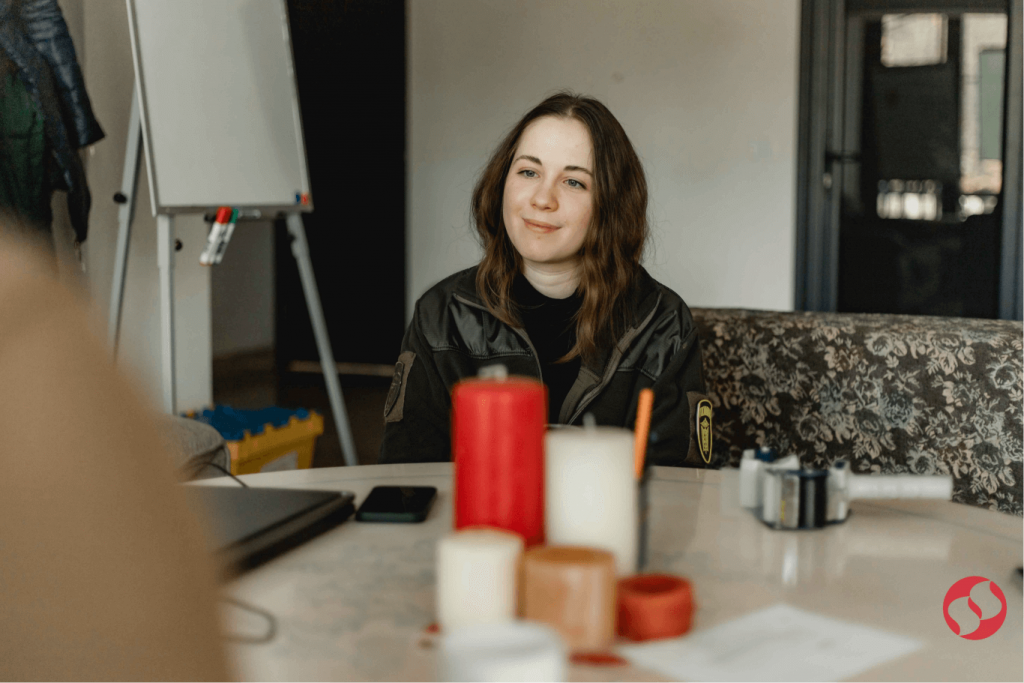
PFVMH HR Manager Darya Ripna during an interview with a future team member
The flow of wounded is growing. While a few months ago, one medics’ rotation provided assistance to 500 wounded, today the number of patients exceeds 2,500. And the number of medics willing to join the PFVMH ranks is decreasing.
“Write that we need anaesthetists, surgeons, emergency doctors, paramedics,” Darya asks. I’d like to add that Sova, the cleaner, also does the work of two people. So, there are vacancies. Although this does not mean that they hire and tolerate everyone. For some people, the dry law becomes an insurmountable barrier. For some, it is difficult to live in a dormitory for a month.
There are foreigners among the volunteers. Medics from the United States, Canada, Australia, Germany, United Kingdom, the Czech Republic and France have passed through the mobile hospital. And this is a matter of particular pride for the PFVMH management. But the truth of life is that not all foreigners, as well as not all Ukrainian medics, pass the test of the dry law. And some were forced to interrupt the rotation because of fatigue and the realisation that the language barrier was insurmountable.
A week before going to the east, volunteers gather in Kyiv. From that moment on, they are “in position” — to leave the location, they need to get permission from their superiors. Then the onboarding starts. A mandatory part of the programme is a two-day tactical training. Some PFVMH veterans are taking it for the tenth time.
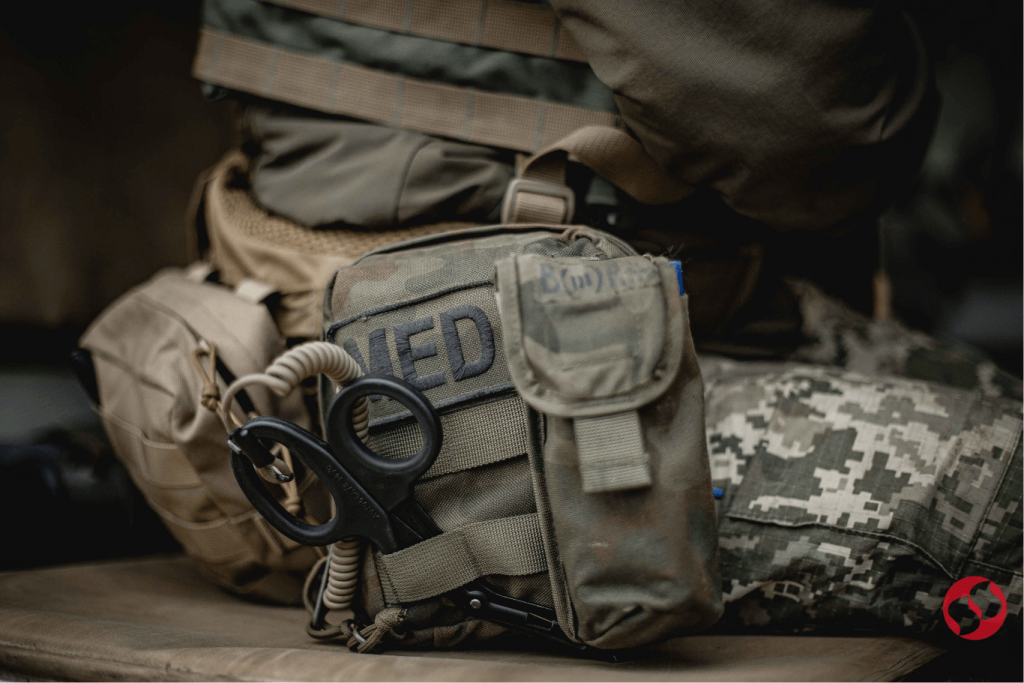
The point is to get the algorithms imprinted on the subcortex and make the movements automatic. The training is led by a young special forces instructor, a certified combat medic. Doctors and candidates of medical sciences, together with drivers and cooks, practice nasopharyngeal airway insertion and other actions on dummies.
Everyone does it differently. In fact, they are very different people. The age ranges from 23 to 50. There are slender young men and overweight associate professors. There are those who radiate frontline experience, and there are beginners. At least those who appear to be beginners.
Over time, when a cinematic epic of this war is created, a gallery of frontline images will emerge. But for now, there are no images, there are living people instead. During an outdoor class, a girl in her twenties leans over a lichen pattern on oak bark. She takes a picture.
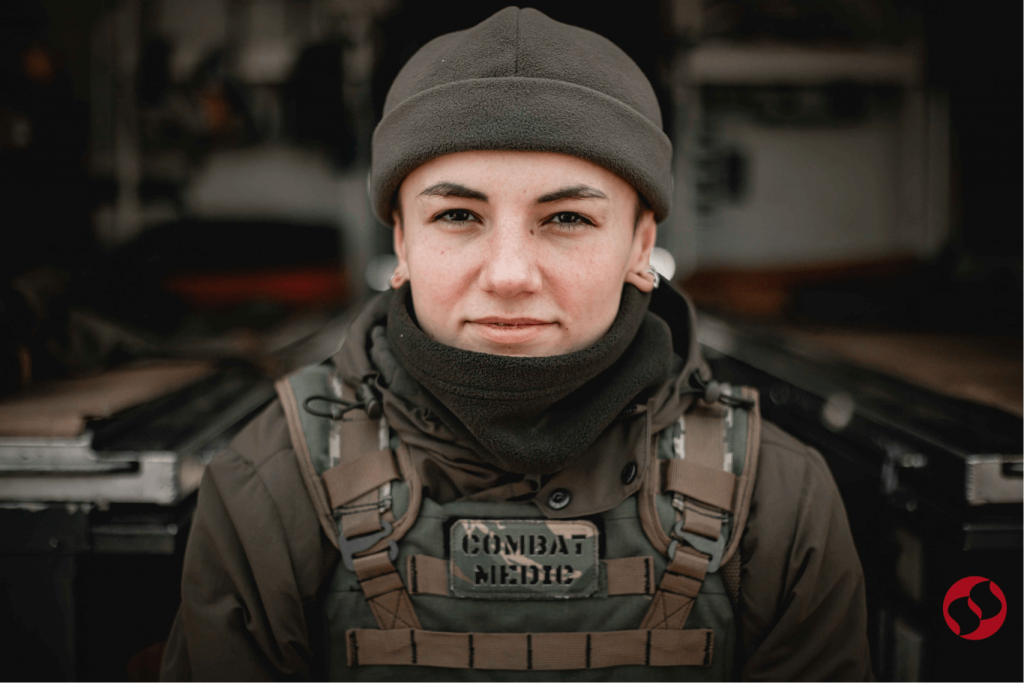
Last fall, 27-year-old Anya (call sign Kapitoshka) went to the frontline with a Defense Intelligence unit on Zaporizhzhya and Kherson axes, then helped the wounded near Bakhmut
She is quiet, keeps to herself, slim, short, with a boyish haircut and tunnels in her ears. Probably going to the front for the first time, probably nervous…
“What is your name?”
“Anya.”
“And the call sign?”
“Kapitoshka.”
“Are you a nurse?”
“An emergency physician. My speciality is resuscitator. I completed my internship.”
Our conversation reveals that Anna is 27 years old and a veteran. Last fall, she went on a frontline tour with a Defense Intelligence unit on the Zaporizhzhya and Kherson axes. In December, she “went to Bakhmut”. Polytrauma, amputations, gunshot wounds…
“Anya, when was the last time you cried?”
“Two months ago. When I was not accepted to the unit I wanted to join.”
After the training, the oath is taken. At nine in the morning, a convoy of minibuses sets off for Subotiv. This is a place of power, blessed with bard Taras Shevchenko’s lines: “In the village of Subotiv / Upon a lofty hill / There stands the coffin of Ukraine, / wide and still: / it is the church of great Bohdan.”
In the church of the Prophet Elijah, near Hetman Bohdan Khmelnytskyi’s coffin, the volunteers swear to serve the people of Ukraine. The volunteers of previous rotations are also awarded here. These are awards from Commander-in-Chief Valerii Zaluzhnyi, foreign intelligence and brigade commanders with whom the PFVMH cooperates.
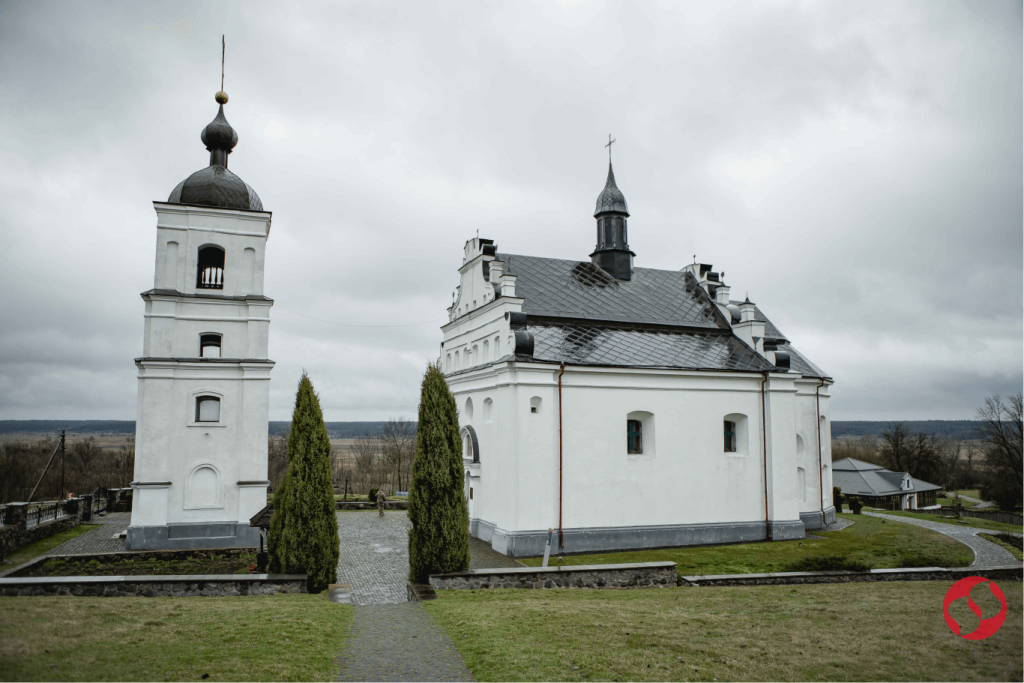
Church of the Prophet Elijah, Orthodox Church of Ukraine, village of Subotiv
Hennadii Druzenko gives a long speech. He quotes Shevchenko and recalls the history of the Cossack state. There is a leitmotif in the speech: the struggle for Ukraine began with hatred of the enemies, but historical failures were also caused by hatred. He concludes: “The enemy must be destroyed, but when he is already unarmed and wounded, I ask you to treat him as a human being.”
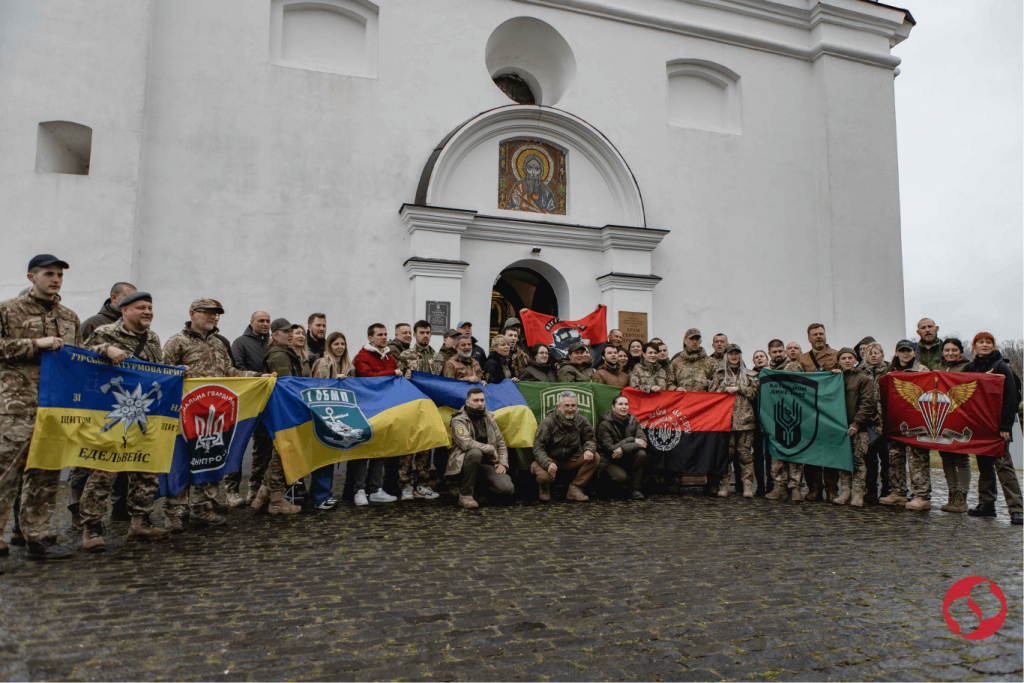
PFVMH volunteers’ oath
A few kilometres away, in Kholodnyi Yar, there is a kolyba (“hut”) where the volunteers have a festive lunch. Afterwards, everyone’s mood is, for obvious reasons, playfully high. On the way back during a coffee stop.
“Martin, we’re going to teach you Ukrainian, so come on, repeat after me: “Shchob lany shyrokopoli, i Dnipro, i kruchi…”
British doctor Martin repeats — rather clearly.
“…Staly vam poperek horla,” the girl continues.
“Staly vam poperek horla,” Martin nods.
The crowd is waiting with bated breath for the final.
“Moskali yibuchi!” the sister recites triumphantly.
“Moskali yibuchi!” Martin exclaims in a flawless, even tone-perfect manner.
General delight, applause. Druzenko’s voice comes over the radio: “To the vehicles”. The feast is over. Tomorrow they go to the front.
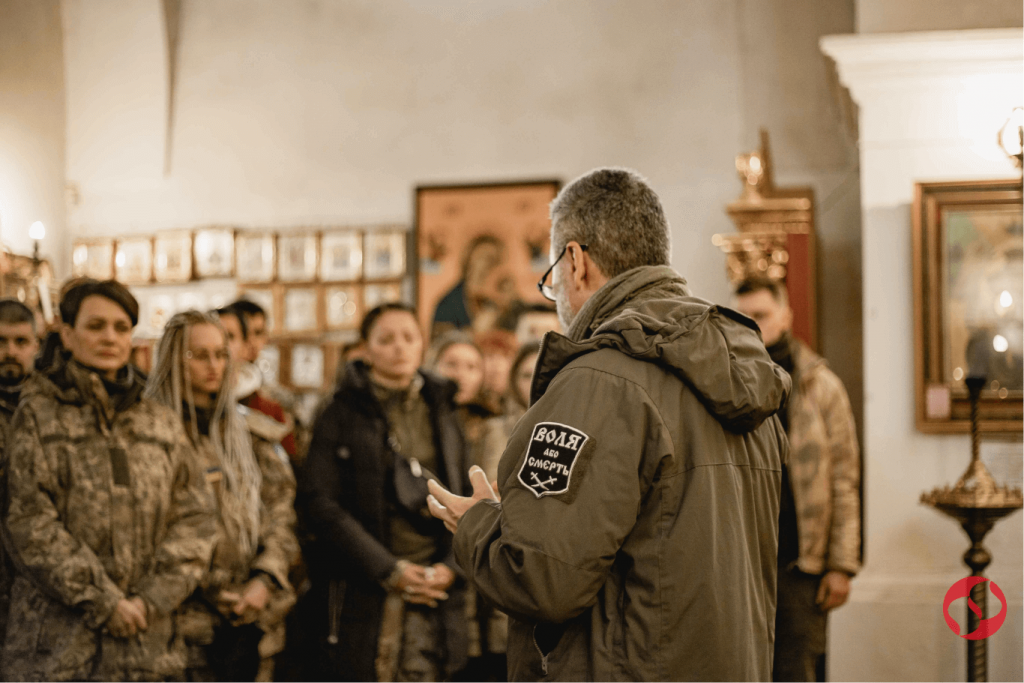
Sermon
Home front
The PFVMH provides an opportunity to use professional skills at the front and in the near-front zone for medics who were not mobilised for various reasons. Some of them were denied service due to their health condition or the presence of minor children. Some, despite their solid surgical experience, have no chance of joining the Armed Forces as doctors because they never passed the military department in the past. And some are even citizens of other countries.
Each person has his or her own unique circumstances. When asked why she decided to volunteer with the PFVMH, one of the elderly nurses said: “At first, I wanted to join an offensive guard brigade, but I was not accepted because I could do only one pull-up. Then I decided for myself: I have five cats and my husband has two stents so I have to return home in a month and check if everything is okay. And then I can go again.”
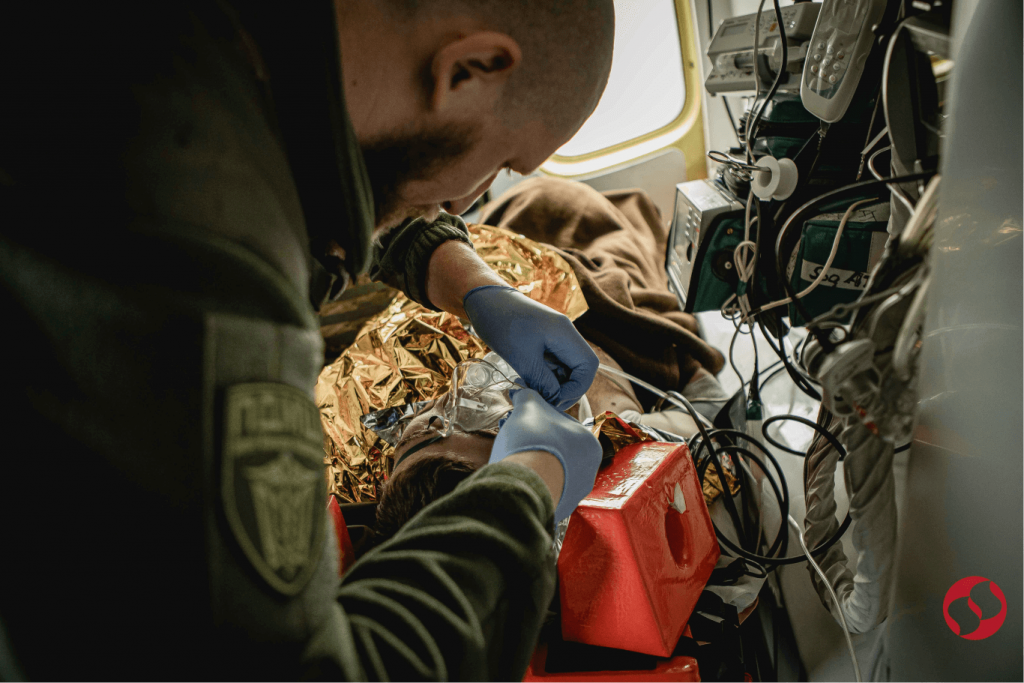
Each volunteer has his or her own reason for joining the PFVMH team
According to Svitlana Druzenko, in March alone, the PFVMH team provided aid to 2,719 wounded. 25% of them were seriously injured and were transported in oxygen-equipped ambulances. What would have happened to them if there had been no PFVMH is one of the most terrible mysteries of this spring.
The cold hard figures turn into an apocalyptic picture when you recall the grey faces in head restraints in the ambulance. Serhii with a perforated skull wound, Mykhailo with a torn abdominal cavity, Valerii with a traumatic amputation of his left foot… all born in 2004. 700 faces, 700 fates. And these are the statistics for just one month.
“The PFVMH turned out to be a monopolist in terms of resuscitation vehicles,” Hennadii Druzenko says and is visibly nervous: “The mobile ICUs became our speciality near Bakhmut. I have not seen any other ambulances at the stabilization units in Lyman or Kostiantynivka but ours.”
The conversation takes place at the hospital’s Kyiv base, in Druzenko’s office, or rather, in his living room. There is a bed, a desk, two armchairs, and a New Testament on the shelf. Dave is lying at the owner’s feet. When the owner raises his voice, the dog raises his head and looks around the room.
“How much does an ambulance cost?” I inquire.
“A new one costs about $100,000. If we talk about our vehicles in the east, they have 800-900,000 km on the clock, the hardware is almost worthless, but the equipment is about $20,000-30,000.
“So, the Armed Forces of Ukraine do not have such funds?”
“It’s just that at one point the mobile ICUs were overlooked in the structure of medical evacuation!”
Dave perks up his ears.
“Quiet, quiet…” the owner calms the dog.
“How much does it cost to operate the PFVMH for a month?”
“From $70,000 to $100,000, depending on the month. The estimate for the whole of last year is about $1 million.”
“Where did the funds come from?”
“Donations.”
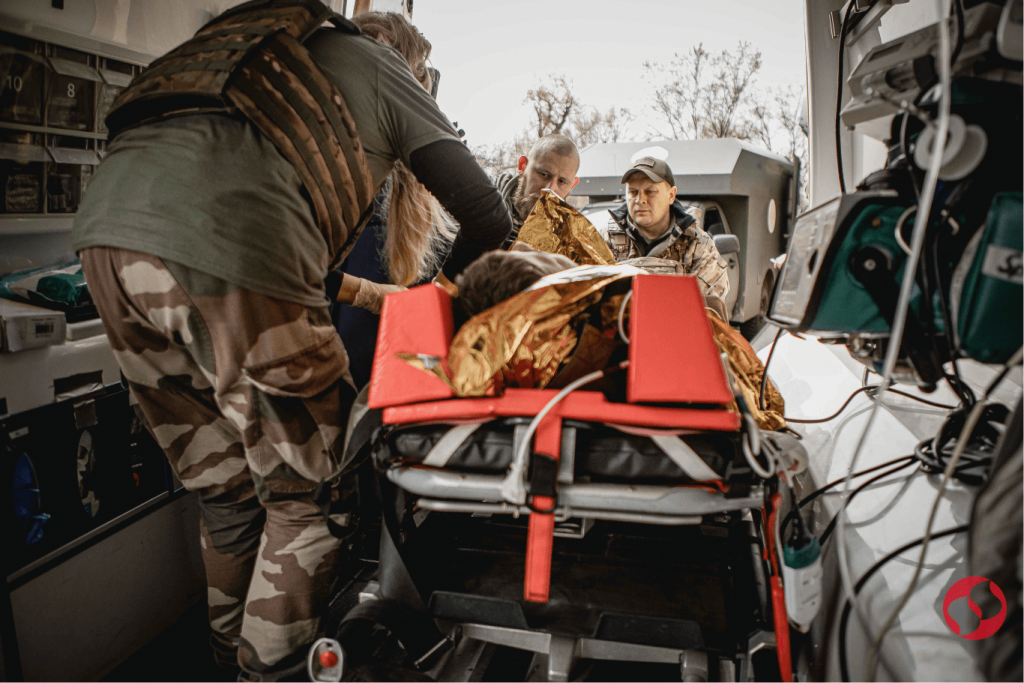
In March alone, the PFVMH team provided aid to 2,719 wounded
According to Hennadii, we can conclude that the situation with donations is similar to that of recruiting new volunteers: the longer the great war lasts, the harder it is to raise them. Public resources are not unlimited. And volunteers need to live somehow, or rather, to live on something.
Some of them risk their lives by spending their own savings. Some doctors, paramedics and nurses are paid for work trips by the medical institutions where they work.
Back in 2016, the Ministry of Health of Ukraine issued an order “On the organisation of the deployment of medical workers who voluntarily expressed a desire to provide medical care in the ATO area”. The document allowed for paid work trips to the ATO zone for civilian volunteer medics.
When the ATO turned into the JFO, then-Minister Ulana Suprun made amendments, but kept the essence. This is how Order No. 814 of the Ministry of Health appeared. But when martial law replaced JFO, no changes were made to the document. A logical question:
“Is Order No. 814 in force or not today, and are doctors paid for work trips?”

PFVMH President Hennadii Druzenko
The PFVMH president smiles wickedly:
“That’s a good question. The order applies mutatis mutandis, i.e. taking into account the changed circumstances. In practice, the heads of some medical institutions pay volunteers the average monthly salary based on this order, but not all of them. There have even been cases where doctors have been fired or punished simply for wanting to go on a rotation to the front. We pay some of our permanent employees a small salary because they have no other sources of income.”
For about 10 minutes, Hennadii Druzenko recalls how he asked the Minister of Health Viktor Lyashko to amend the order, but to no avail. At the words “Minister Lyashko”, the dog starts to growl. Apparently, this is not the first time Dave has heard this name.
The relationship between the PFVMH and state representatives resembles a positional war that has been going on for years. The latest escalation occurred in Kramatorsk in June 2022. An ambulance brought a wounded soldier from a stabilization unit to the hospital, but the chief medical officer of one of the units refused to admit him, arguing that PFVMH doctors were nobodies in his eyes. Eventually, the soldier was admitted, but with a scandal.
The PFVMH founder takes out his smartphone. His glasses slide down to the tip of his nose:
“Let me tell you the date right now… I wrote to the commander of the Medical Forces, Tetiana Ostashchenko, on Whatsapp,” he quotes from the phone: “Congratulations! I admit that our relationship did not work out, c’est la vie, but this is not a reason to take wounded soldiers hostage…”
“Did you receive a response?”
“They replied… that my information was not true. Here it is, on June 23 last year. I then publicly appealed to Commander-in-Chief Valerii Zaluzhnyi. The next morning, we prepared a petition to involve the PFVMH in the medical evacuation of the wounded. In the evening, we received a resolution: “Permission granted.”
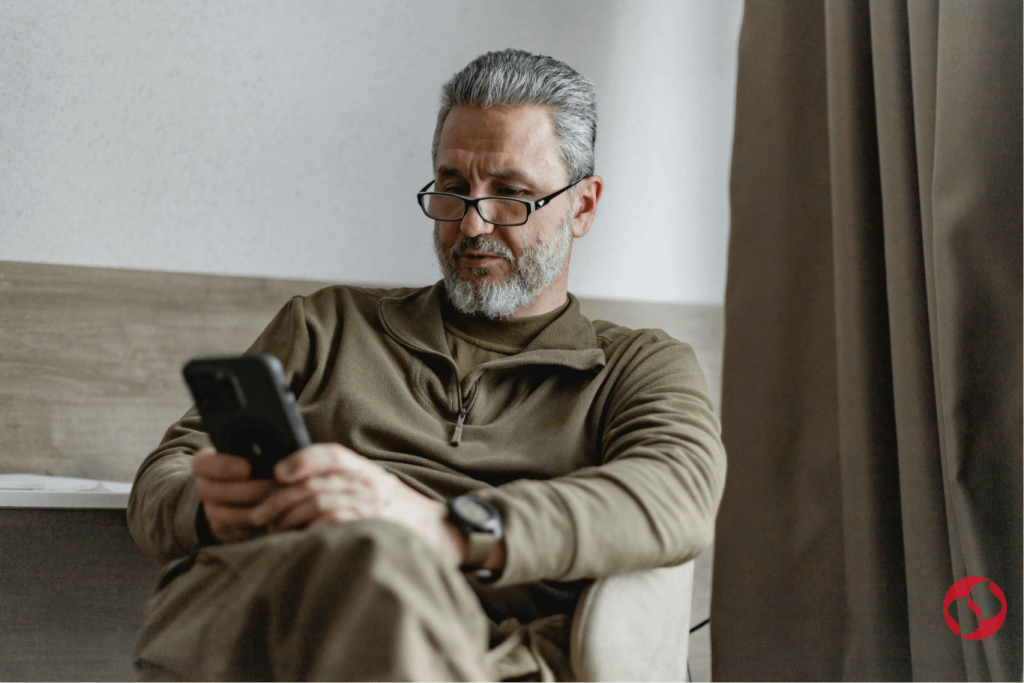
PFVMH founder takes out his smartphone, glasses slide to the tip of his nose
“So, it turns out that the salvation of hundreds of wounded every month depends on the signature of one person?”
“Yes. Granting PFVMH veterans the status of combatants is a story in its own right.”
“Is it possible?”
“It was possible. But only through the courts,” Druzenko touches some papers on the table: “Here we have, so to speak, another front…”
Dave sighs tiredly.
“Do you see a way out of this situation? Any legislative changes?”
“In order for something to move forward, the psychology of government officials must change. And the draft laws… They exist. The PFVMH could operate as a private military medical company. Government procurement would allow us to pay people salaries.”
There is hope in Druzenko’s eyes:
“There are different mechanisms — medical outsourcing, using the principle of ‘money follows the patient’… After all, private companies repair military equipment, sew clothes, provide transport services to the military… After all, most of the weapons we receive from our Western allies and partners, including the legendary HIMARS, are produced by private companies. Why can’t we officially provide medical evacuation services?”
Druzenko thinks for a moment and suddenly crosses out the above:
“But… To be honest, I don’t believe in it, because I know our state machine too well. I don’t want to have anything to do with it.”
“What do we do then?”
“Fight.”
At the top
PFVMH volunteers have been living their monastic life — some for a month, some for almost a year. They are aware that they will not receive benefits and will not earn money. And in case of their death, their families will not be entitled to UAH 15 million ($407,199) in one-time assistance.
If you ask one of them somewhere in Lyman or at the base in Sloviansk, why do you do all this, they will be surprised. The answer is obvious and at the same time complicated. It is difficult to formulate, but you can feel it. In dozens of conversations, I have asked this slightly indecent question.
“I’m an anaesthetist, working here is my contribution to the common cause, it’s the best I can do,” says Skrypal (Viktor Skrypchenko). “Everything here is somehow more meaningful,” Delta ambulance doctor (Dmytro Shklyar) says. “I have to be here,” says emergency specialist Sumy (Heorhii Snitsar). But all these are words that conceal something.
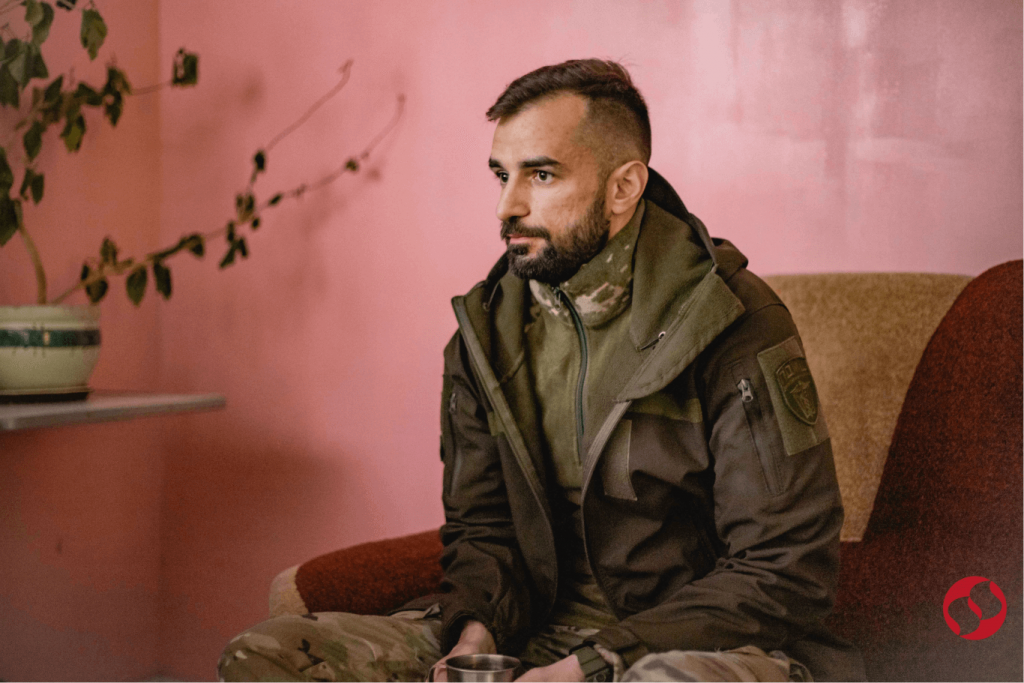
Young doctor Heorhii Snitsar (call sign Sumy) has completed six rotations with the PFVMH team
The atmosphere in which volunteers live in the east is different from the atmosphere in Kyiv or Lviv. War makes people a little depressed, sometimes angry. Even if they pretend there is no war.
Everyone reflects in their own way. Someone feels a guilt complex, someone is looking for internal enemies, someone is in a sub-depressive state. And this is, after all, natural. But there is a different emotional background at the volunteer base.
Young doctor Heorhiy Snitsar spent six months with the PFVMH. He has helped at least 370 wounded. He has seen enough to last an average person several lifetimes. He answers questions thoughtfully and with a little distance.
“Heorhii, when was the last time you felt angry?”
The doctor is silent for a few seconds, as if remembering a long-forgotten word:
“Do you mean unprovoked acts of aggression? No, I am calm.”
To feel inner peace. Perhaps this is the meaning of the koan that the cleaner Sova spoke of. Perhaps this is how the magical flute mentioned by the driver Mozart sounds. Perhaps it is something similar to what a climber experiences at the top.
Projects is proudly powered by WordPress